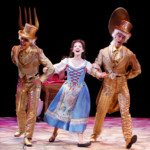There is a science to finding pointe shoes to fit a dancer’s feet perfectly. Pointe shoes are not shoes that a dancer can go buy in her normal street shoe size. There are several things to take into consideration when buying pointe shoes – (box type, platform shape & width, shank strength, shoe height, vamp length, and heel height & width.) Along with making sure all these things fit properly, a dancer needs to make sure that laces are sewn on properly, that toe gel pads are worn, and that care is taken to endure proper usage.
All of this information might seem overwhelming. However, all of these considerations are crucial for proper fit. If the shoes do not fit correctly, the result to the dancer could be a sprained or broken ankle, or even a broken leg.
A dancer wants the box type to be the right shape for her toes. There are three different box types – tapered, slightly tapered, and square. The angle her toes are across the end of her foot will determine how tapered she needs her shoes. The more level her toes are with each other, the more likely she will need a square box. The box is the base of the shoe that the dancer stands on when she is dancing.
The Right Pointe Shoe Will:
- Allow the dancer to reach her potential without constant worry over her shoes.
- Protect the delicate parts of the foot, including the toes and toenails!
- Closely follow the contours of the foot, offering support in the shank and box
- Compliment the dancer’s lines
- Allow a dancer with “less than ideal feet” to dance to her physical maximum
- Help correct certain bad habits or physical limitations
The Wrong Pointe Shoe Can:
- Cause pain, bruised toenails, or even bunions
- Be challenging to pad correctly
- Twist in the shank
- Allow the dancer to sink down into her shoes
- Force all weight on the big toes
- Prevent the dancer from getting over her box
- Force the dancer to stand sickled (the heel scoops down too far back) or pronated (the foot rolls inward)
A major factor in pointe shoes is the lacing. In most cases, when a dancer receives pointe shoes she will need to sew on the laces herself. The laces need to be sewn directly level with the middle of the archway of her foot. Sewing the lace too close to the toes or heel can result in the laces not being tired correctly. This is where a domino effect comes in to play: incorrect lacing can cause the ankle to be too loose in the shoe. This makes the ankle susceptible to a sprain or breaking.
Once a dancer receives the correct pointe shoes, they can buy gel or wool toe pads. The preference for gel or wool toe pads depends on the dance instructor’s approval. These pads are placed over the toes before a dancer puts her foot into the shoe. These pads help cushion and lighten balancing on the wooden block. Sometimes these pads can cause warts, blisters, etc., because of the foot sweating inside the pad. Powdering the pads with baby will help keep the foot dry, preventing warts, blisters, etc.
A local dancewear shop, such as Bobbi’s Dancewear, properly sizes a dancer’s feet for pointe shoes. Bobbi and her employees are all trained to measure the dancer’s feet to help the dancer find the correct pointe shoes. With the dance instructor’s guidance, the expertise of a dancewear shop, and having knowledge of the pointe shoes, a dancer is set on a great path to finding the correct shoes for her!
If you are interested in taking pointe dancing classes, come to OSMD today! Sign up for classes.



